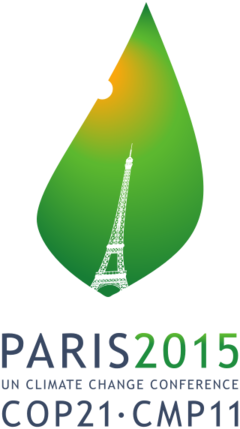COP21
 | |
| Date | 30 November 2015 - 12 December 2015 |
|---|---|
| Interest of | Greta Thunberg |
The 2015 United Nations Climate Change Conference – known as COP21 – was held in Paris from 30 November to 12 December 2015. It was the 21st yearly session of the Conference of the Parties (COP) to the 1992 United Nations Framework Convention on Climate Change (UNFCCC) and the 11th session of the Meeting of the Parties (CMP) to the 1997 Kyoto Protocol.
COP21 negotiated the Paris Agreement, a global agreement on the reduction of climate change, the text of which represented a consensus of the representatives of the 196 attending parties. The agreement enters into force when joined by at least 55 countries which together represent at least 55 percent of global greenhouse gas emissions. On 22 April 2016 (Earth Day), 174 countries signed the agreement in New York, and began adopting it within their own legal systems (through ratification, acceptance, approval, or accession).[1]
According to the organising committee at the outset of the talks, the expected key result was an agreement to set a goal of limiting global warming to "well below 2°C" Celsius compared to pre-industrial levels. The agreement calls for zero net anthropogenic greenhouse gas emissions to be reached during the second half of the 21st century. In the adopted version of the Paris Agreement, the parties will also "pursue efforts to" limit the temperature increase to 1.5°C, which will require zero emissions sometime between 2030 and 2050, according to some scientists.
Prior to the conference, 146 national climate panels publicly presented a draft of national climate contributions (called "Intended Nationally Determined Contributions", INDCs). These suggested commitments were estimated to limit global warming to 2.7°C by 2100. For example, the EU suggested INDC is a commitment to a 40 percent reduction in emissions by 2030 compared to 1990. The agreement establishes a "global stocktake" which revisits the national goals to "update and enhance" them every five years beginning 2023. However, no detailed timetable or country-specific goals for emissions were incorporated into the Paris Agreement – as opposed to the previous Kyoto Protocol.[2]
A number of meetings took place in preparation for COP21, including the Bonn Climate Change Conference, 19 to 23 October 2015, which produced a draft agreement.
On 12 December 2015, the participating 196 countries agreed, by consensus, to the final global pact, the Paris Agreement, to reduce emissions as part of the method for reducing greenhouse gas. In the 12-page document, the members agreed to reduce their carbon output "as soon as possible" and to do their best to keep global warming "to well below 2 degrees C". In the course of the debates, island states of the Pacific, the Seychelles, but also the Philippines, their very existence threatened by sea level rise, had strongly voted for setting a goal of 1.5°C instead of only 2°C. France's Foreign Minister, Laurent Fabius, said this "ambitious and balanced" plan was an "historic turning point" in the goal of reducing global warming. However, some others criticised the fact that significant sections are "promises" or aims and not firm commitments by the countries.[3]
Related Quotation
| Page | Quote |
|---|---|
| International Maritime Organization | “Despite being responsible for close to 3% of global greenhouse gas emissions, the shipping sector remains outside of the UN Paris Agreement on climate. It has achieved this through corporate capture of the International Maritime Organization” |
References
Wikipedia is not affiliated with Wikispooks. Original page source here